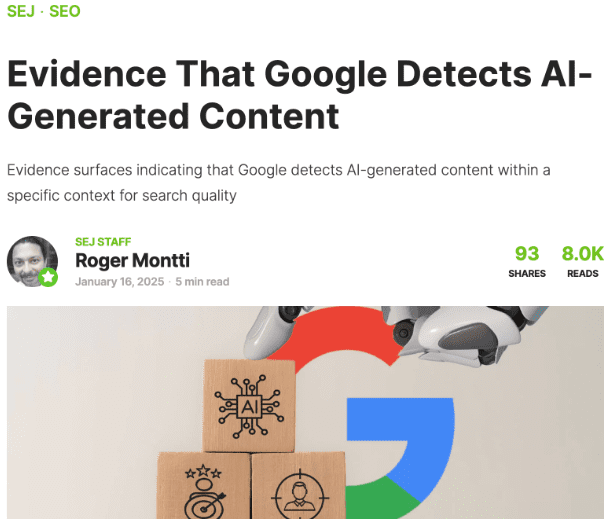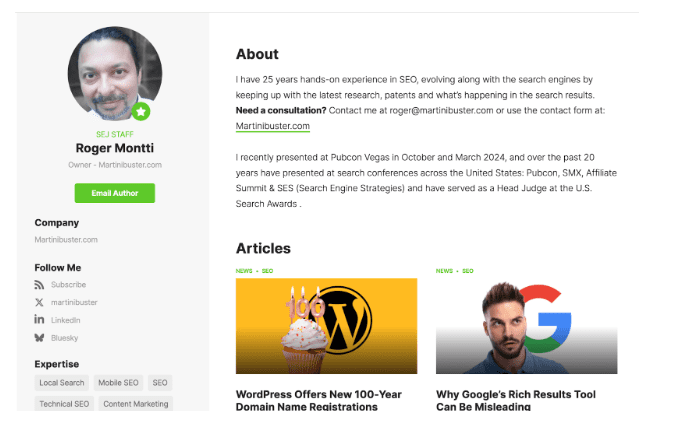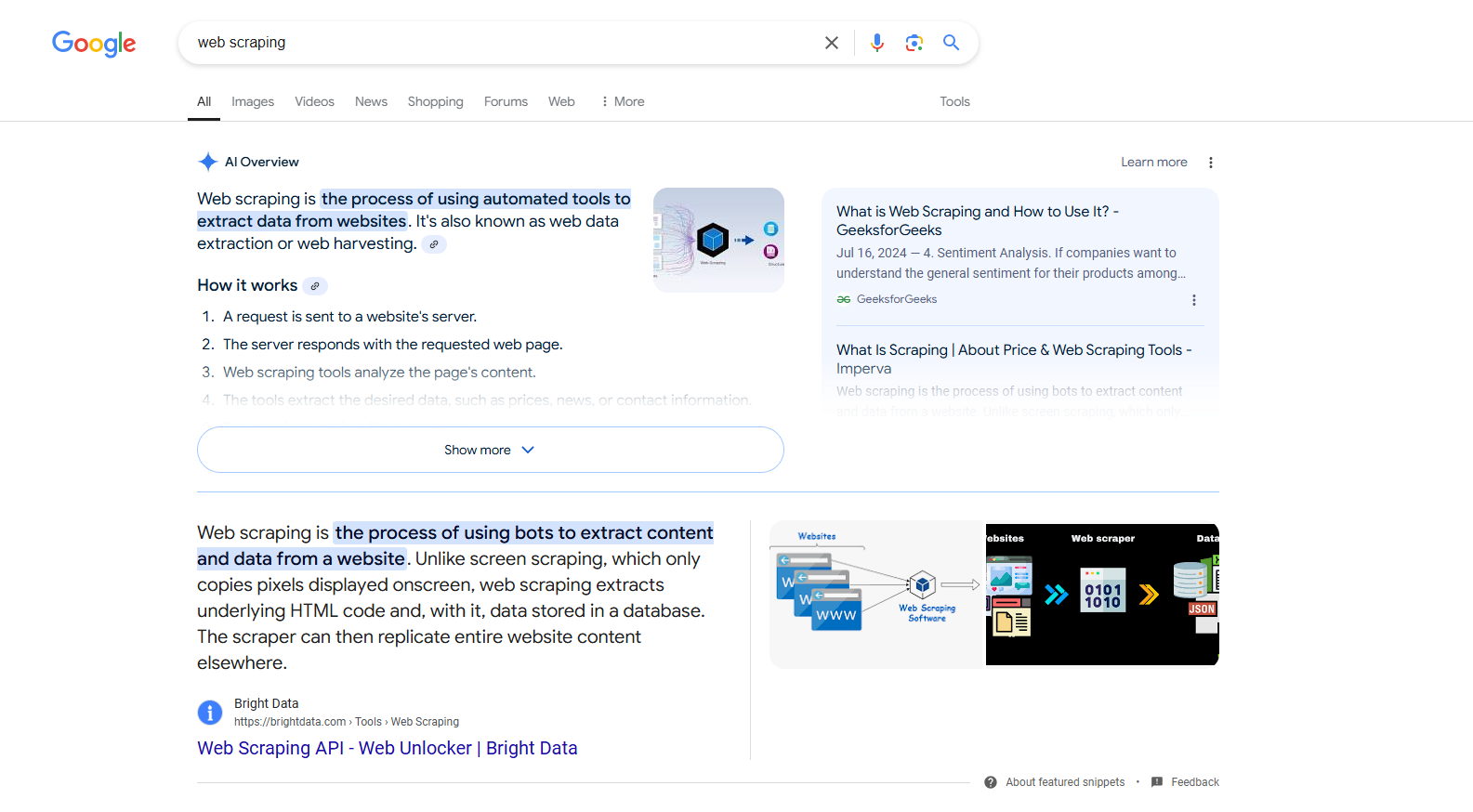How To Increase Google Discover Visibility Naturally Using These Ranking Signals via @sejournal, @rollerads
This post was sponsored by RollerAds. The opinions expressed in this article are the sponsor’s own.
Want more visibility in Google Discover?
Not sure how to get into Google’s personalized news feeds?
Discover isn’t like search. You don’t rank for keywords.
You get selected.
And that means the best way to get featured isn’t to optimize for keywords; it’s to optimize for specific algorithmic signals.
In this guide, we’ll cover the core ranking signals that help Google determine which content belongs in Discover feeds, and how you can naturally boost those signals using tools like push notifications.
Google Discover Optimization Tips: Which Signals Tell Google Your Content Belongs in Discover?
Google Discover uses a different algorithm from traditional search results.
While it still considers many of the same quality indicators, Discover visibility depends less on keywords and more on how your content performs in the real world.
Here are the most important content quality signals for Discover.
1. E-E-A-T: Experience, Expertise, Authoritativeness, Trust
A good rule of thumb is to follow the “E-E-A-T” guideline:
- Experience: Firsthand, real-world familiarity with the subject.
- Expertise: Deep knowledge and skill in your content niche.
- Authoritativeness: Recognition from other trusted sources.
- Trustworthiness: Accurate, unbiased, and reliable information.
2. Engagement Metrics
These tell Google your content resonates with users and may be worth promoting more widely.
3. Strong Visuals & Headlines
Discover is highly visual, so if you don’t stand out immediately, the users are likely to scroll past your content.
Take your time to polish headlines to get attention, but make sure they accurately reflect the content of your article, post, or whatever you’re writing right now.
Engaging headlines, images, and videos perform better, especially when those assets are optimized for mobile.
4. Technical SEO & Mobile Optimization
While you don’t need to “rank” per se, you do need a well-optimized site, which includes:
- Fast load times: Consider page speed and overall efficiency. Use PageSpeed Insights to ensure your web pages are optimized for user performance.
- Mobile-friendly layouts: Google Discover is only available on mobile devices, as there is currently no desktop version.
- Structured data: Google relies on structured data to categorize content and provide relevant suggestions for users. To attract more engaged and relevant users, you need to add tags and structure data so that Google can better recognize and categorize your content.
- Internal linking & link building: It will help you create your own network of content. This concerns old articles, too, as they might serve as a gateway to newer pieces of content.
- RSS or Atom Feed: Allow users to follow you to receive updates quickly. Google generates a feed for you automatically, but you can connect your own.
- Google Web Stories: Similar to Instagram, these stories appear under the Visual Stories banner on mobiles and serve to expand your reach. Stories are easy to create, engaging, interactive, and fun.
Track, test, improve. Use Google Search Console (GSC) to monitor your performance and statistics. Unlike Google Analytics, it has a dedicated tab for monitoring Google Discover traffic.
5. Freshness & Topical Relevance
Valuable content addresses and solves pain points.
For content to have a better chance of showing up in Discover feeds, it should be:
- Accurate.
- Timely.
- Trending.
- Helpful.
- Continuously updated.
This is especially powerful if your content is tied to current events or spikes in interest, as shown in Google Trends.
To discover what users search for, try:
- Google Search: Enter a query and scroll down to view related and popular requests.
- Google Search’s Autocomplete: Start typing a search and observe the suggested autocomplete queries; these are the queries that many others regularly search for.
- Google Trends: Identify how popular a content direction is in any part of the world. This is also great for identifying seasonality.
How Google Discover Works
- Google Discover suggests your content, which should include all the positive signals mentioned above.
- The Google app user engages with your content within Google Discover, adding to Google’s knowledge of how users interact with your website.
- These engagements (visitor volume, time on page, user experience, etc.) indicate to Google that your content is well-suited for similar readers.
- Google increases your reach and visibility on Google Discover.
- Those new viewers engage with your content in a similar pattern.
- The cycle repeats, spreading your optimized content to more Google Discover timelines.
This is known as a positive loop because your content consistently passes positive ranking signals back to Google’s Discover algorithm, thereby continuing to increase in engagement.
How Do I Create A Positive Loop & Show Up In Google Discover?
Now that you know what Google is looking for, here’s how to naturally boost those signals.
We know that Google Discover places your content based on:
- High-clickthrough rates.
- Long time-on-page.
- Repeat visitors.
So, how can you increase those metrics?
By getting a dedicated reader base that is always ready to consume your new content.
Push notifications are a great way to alert your dedicated readers that new content is out.
And they will feed your Google Discover algorithm data.
How To Use Push Notifications To Boost These Google Signals
Many publishers avoid push notifications, believing they’re too promotional or might harm user experience (UX).
However, modern push notification platforms allow you to take a more hybrid approach, combining editorial updates with monetization to boost visibility.
Why Hybrid Push Notifications Help Boost Discover Visibility
Done right, push notifications help your content get discovered organically by:
- Increasing CTR with a second wave of distribution.
- Driving fast engagement shortly after publication.
- Bringing back repeat readers to increase session depth.
- Boosting behavioral signals that Google uses to judge quality.
In other words, push notifications support the very engagement metrics that can lead to more Discover visibility.
When users receive a mix of informative and promotional pushes, each message feels fresh, encouraging clicks and boosting your CTR.
Higher engagement signals to Google that your content is valuable, increasing the chances of it being featured on Discover.
And since Discover traffic is largely made up of new visitors, each one becomes a fresh opportunity to grow your subscriber base.
Once users opt in, you can keep re-engaging them, creating a cycle of rising visibility, CTR, and traffic.

Image created by RollerAds April, 2025
How to Implement Hybrid Push Format to Get on Discover Faster
In a recent case study, one RollerAds publisher increased their revenue from $0 to $60,000 per month by pairing great content with hybrid push notifications and Discover-optimized distribution. The key was creating content that signals quality and leveraging distribution to show it.
With a tool like RollerAds, you can gain a streamlined way to:
- Send personalized push notifications for your latest content.
- Mix promotional and editorial messaging without spamming your readers.
- Increase engagement, retention, and revenue simultaneously.
Simply register your site, get a custom strategy from your account manager, and start boosting content visibility, without compromising user experience.
Even better? You can monetize this traffic directly with ad formats designed for Discover audiences, no intrusive pop-ups or poor user experience. Just clear, engaging content with a side of revenue.
For SEJ readers, use the code SEJ30 to add +30% to your funds before July 1st, 2025.
Just show the code to your account manager on RollerAds before your first payment.
Getting featured on Google Discover isn’t just about luck; it’s about strategy.
From creating high-quality, relevant content to optimizing visuals, headlines, and mobile performance, every step counts. However, to truly stand out and amplify your chances, pairing content strategy with smart tools, such as hybrid push notifications from RollerAds, can make all the difference.
Engaging your audience through push updates not only drives more clicks but also signals content quality to Google, boosting your Discover reach. With the right monetization tools, you can convert that traffic into substantial revenue.
Image Credits
Featured Image: Image by RollerAds. Used with permission.
In-Post Image: Images by RollerAds. Used with permission.




















